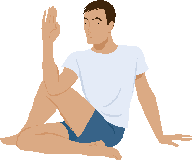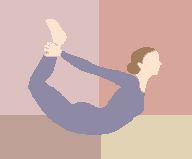All of us are now more health conscious & aware of the need to exercise. Weight training, treadmill, brisk walks, cycling, swimming, dancing, outdoor sport, trekking, yoga, taichi, dance forms are some of the activities we make a choice from.
Though yoga is prevalent in India since 2nd& 3rd Century B.C., BKSIyengar had popularized Patanjali yoga in India & the Western world. Increased indulgence incompetitive sports has led to more wear & tear of joints & ligaments which has kind of pulled people towards yoga in order to increases muscular suppleness, endurance, joint flexibility and agility.
Many people start taking yoga purely for physical reasons – to lose weight, to become more flexible, to get a stronger core, etc.… What they discover is that yoga is so much more than a physical practice. Yoga also has the remarkable ability to calm the mind, illuminate the soul and open the heart. Yoga is not recommended,by itself, for losing weight, reducing cholesterol or as a cardiovascular exercise. It should be an adjuvant to any form of aerobic or cardio exercise. Yoga can complement exercises; not replace it
If a person simply wants to get fit, yoga can be the answer. The five areas of fitness are
- body composition,
- muscular strength,
- muscular endurance,
- cardiovascular endurance and
In dynamic styles of yoga such as Ashtanga, Power Yoga and Flow all areas of fitness are getting addressed. Total fitness gains, however are not completely addressed in all forms of yoga. Some styles are too gentle to achieve improvements in body composition, muscular strength, muscular endurance, or cardiovascular endurance.
Nearly all forms of yoga in studios or health clubs produce only flexibility gains. The gentler forms of yoga are also good for muscular rehabilitation and stress reduction. Hence Yoga will best serve as an adjunct to the sports specific training by keeping the muscles supple, preventing injury, improving breath control, and focusing the mind.
Sun salutations are very beneficial in obesity management. Every day 24 sun salutations with a speed of 4 rounds in 1 minute give great benefits of Yoga Asanas and exercise as well.
Yoga has also been linked to lower cholesterol and triglyceride levels and better immune system function. It is great for normal functioning of the endocrine system due to its effect on the hypothalamus, pituitary axis. Balancing postures, neck exercises help to prevent vertigo, symptoms of cervical spondylitis& cerebellar problems of old age. Physiotherapy followed by back stretches & strengthening exercises of yoga, coupled with swimming can rectify an early vertebral disc prolapse.
Yoga has long been known to lower blood pressure and slow the heart rate. A slower heart rate can benefit people with high blood pressure and people who’ve had a stroke.
- Pranayamas along with stretches help in increasing lung capacity, thereby improving lung function in obstructive lung disease patients (asthma)&reducing frequency of asthma attacks.
- Specific kriyas help in detoxifying specific systems, which stabilizes the immune system, reducing the severity of all allergic reactions.
Both yoga and aerobic exercise offer significant health benefits including improved muscle tone, decreased body fat and improved mental outlook. When compared in key fitness categories, aerobic exercise outperforms yoga.
Aerobic exercise burns more calories than yoga for any time period. Although aerobic exercise produces endurance — the ability to sustain an activity for an increased amount of time — it does relatively little to increase strength.
Although yoga involves systematic breathing that improves respiratory fitness, ultimately aerobic exercise outperforms yoga in the cardiovascular arena because it involves elevation of the heart rate for sustained periods of time or for distinct intervals. This improves the efficiency of the heart muscle, allowing it to do more work with less effort during rest times.
Since each form of exercise has its strengths and weaknesses one should select according to one’s fitness goals.
- Ashtanga and power yoga, are very physical. Practicing one of these styles will help you improve muscle tone.
- Even less vigorous styles of yoga, such as Iyengar or hatha, can provide strength and endurance benefits.
- When done right, nearly all poses build core strength in the deep abdominal muscles. With a stronger core, you’re more likely to sit and stand “tall”.
- Yoga also helps your body awareness. That helps you notice more quickly if you’re slouching or slumping, so you can adjust your posture.
Sense of balance is brought about through balancing postures, pranayama or breathing techniques (specifically a technique called anulomaviloma breathing, which encourages equal balance between idea and pingalanadis) and meditation. Balancing postures help you focus on ajna chakra (an energy point located at the forehead specific to balance between our left and right sides) and hence bring balance into your everyday life.
Asanas&pranayamas enhances body-mind coordination, thereby increasing confidence, positivity, self-esteem, contentment, happiness,better interpersonal relationships &internal peace.
To conclude, Yoga is a way of life. The philosophy of Yoga needs to be incorporated in day to day life. The yamas(Don’ts) &niyamas(Dos) of yoga give a direction to the way of leading one’s life. This coupled with asanas helps one in disciplining one’s life, perform our duties with focus, in a balanced and relaxed state of mind thereby reducing stress and keeping all our systems in a well-balanced state.
Dr Suman Rao, an MBBS, 20 years of practice in family medicine, has won awards for presenting papers on cases and over 5 years of training claims accessors on cases.





Please comment with your real name using good manners.